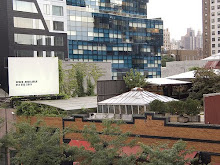




1) The Downtown by Philippe Starck, 15 Broad Street (The Real Deal Online). 2)
15 Broad St., New York, NY 10005
The 42-story J.P. Morgan building at 15 Broad Street was converted into condominums in 2004, into a development known as Downtown by Philippe Starck1. The development was an instant success partly due to its historic location and its panoply of amenities, which include a bowling alley, a swimming pool, a yoga studio, a raquetball court, a basketball court, a children's playroom and Starck Park, the stylish terrace overlooking the New York Stock Exchange, located on the rooftop of 23 Wall Street.
The French product designer, Philippe Starck, signed onto work with project architect, Ismael Leyva of the architectural firm Yoo USA early in 2003, in attempts of creating a "paradise island" which would "embody 'honesty, respect, tenderness, surrealism, poetry, suprise, vision," aspects which Starck believes otherwise have no value to the enterprises of the Financial District.
Upon enterance to the Downtown, residents are greeted by the development's warm staff and the orginal Louis XV chandelier which hung in 23 Wall Street, otherwise known as the House of Morgan. The 1,900 piece chandelier withstood one of the nation's first terrorist attacks on September 20, 1920. J.P Morgan and Company, which at the time of the attack was administrated by Junius Spencer Morgan, grandson of the late J.P. Morgan Sr, was one of the few banking establishments to have survived the gruesome gripes of World War I, walking away as the "undisputed leader of global finance" 2. As the bells of Trinity Church chimed the noon hour, "a bomb planted on a horse-drawn wagon exploded into the lunchtime crowd at Wall and Broad Street," instantly taking the lives of 30 people and leaving another 300 injured. The attacks were never completely resolved, but as costumary of the time, the blame was placed on anarchist circles, "awash with praise for dymnamite as a transformative tool," one which would provide "the working class with firepower to match the enemies of the state"3. Junius Spencer Morgan and the chandelier, which is made of Swarovski crystals and is publicly displayed in Downtown's lobby, made it out of the attacks relatively unscathed. 23 Wall Street, whose facade still bears evidence to the attack, has been reconstructed, and its rooftop is currently home to Starck Park, to which Downtown residents have unlimited access.
One of the more fascinating ammenties of Downtown is its impressive children's playroom located within the building's gym on the third lower level. Aside from the building staff, there are other privately hired workers who call Downtown their place of employment. Downtown's domestic workers, who are often found in the children's playroom, are often a part of an informal industry, one which allows for women of color, in particular Latina women, to be subjected to hierarchy, in which "race, ethnicity, gender and class relations can" no longer "be summarized in monistic theories or additive models"4. Instead, these entities must be understood as intersecting systems of power relations, molded by the sort of work they perform for people which oftentime claim to see them as "one of the family"5. The work day never seems to end for these women, who after caring for their employers' children for long hours often have to travel to tend to their own families. The distinction between their own personal lives' and that of their workplace often becomes blurred, as the responsibilities never cease. Despite their ardous and occassionally exploitative labor, the domestic workers of Downtown tend to form special bonds with their employeers, especially with the young ones to whom they tend.
Directions:
J, M, Z to Wall Street station, walk southward to 15 Broad Street.
4, 5 to Wall Street. Exit is Broadway, walk onto Wall Street, make a right at Broad St.
1, 2, 3 to Wall Street. Exit is on Wall St and William St. Walk westward on Wall Street, make a left on Broad St.
References
1. Dunlap, David W. "Condos, Not Roll-Tops, on Finance's Holiest Corner." The New York Times Company: 11 May 2004.
2. Gage, Beverly. The Day Wall Street Exploded. Oxford: Oxford University Press, 2009.
3. Berret, Jess. "The Day Wall Street Exploded: A Story of America in Its First Age of Terror." San Francisco Gate: 8 March, 2009.
4. Hondagnue-Sotelo, Pierrette. "Working 'Without Papers' in the United States: Toward the Integration of Legal Status Frameworks of Race, Class and Gender." Women and Work: Exploring Race, Ethnicity and Class. Vol. 6, p 101-125. Sage Publications, 1997.
Romero, Mary. "Life as the Maid's Daughter: An Exploration of the Everyday Boundaries of Race, Class and Gender." Challenging Fronteras: Structuring Latina and Latino Lives in the U.S. p 195-209. Routledge: New York, 1997.

Great post!
ReplyDeleteI really need some visual inspiration like this for my next design project for graduate school.
Can you give me advice on some designers for more inspiration like this one, Beau Mcclellan, Serge Mouille or
Deligfhtfull.
Find out the perfect mix between 40’s, 50’s and 60’s music legacy and lighting pieces!
Visit www.delightfull.eu or
www.youtube.com/DelightfullLighting and by the way visit also www.bocadolobo.com. they have beautiful luxury pieces!
I really enjoyed your blog. I’ll come back to see what you post next!